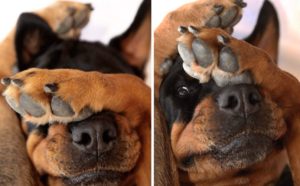My older work was based on cover-up and reveal. I used masking fluid . . . ok . . . .rubber cement, to mask off areas of the canvas before flooding it with (usually) very wet washes of (usually) transparent color. When the paint dried, I’d remove the mask and do it again and again and again. Sometimes I’d leave one mask on while adding another with a wash in between.
 Needless to say, my large art-deck studio at The Curlew Compound in San Diego was littered with little balls of rubbed-off rubber cement! I often toddle around the house in white socks (no shoes), and destroyed dozens of pairs by inundating them with wads of rubber cement hiding on the floor!
Needless to say, my large art-deck studio at The Curlew Compound in San Diego was littered with little balls of rubbed-off rubber cement! I often toddle around the house in white socks (no shoes), and destroyed dozens of pairs by inundating them with wads of rubber cement hiding on the floor!
Layer after layer and mask after mask, the pieces developed a depth and vibrance over time that was fun to view. Often, the viewer’s mind made all kinds of things appear within the swirling paintings (which, by the way, is called ‘pareidolia’: a psychological phenomenon involving a stimulus (an image or a sound) wherein the mind perceives a familiar pattern of something where none actually exists. It’s how we come up with the man-in-the-moon and pyramids on Mars). I enjoyed going to the big restaurant that featured those paintings for several months to watch people eating and staring, nudging their table mates and pointing.
The problem was not the pieces, the product: that was just fine. The problem was the process. It was almost painful: deadly slow, physically demanding (I got blisters and then calluses on my hands from rubbing!), and filled with long sessions of staring at the canvas, not painting. I wasn’t having much fun.
The newer work is a reaction to that excruciating process. Nearly unconscious spontaneity is integral to it and there is much less staring and waiting for something to gel. However, I’m finding that the philosophical underpinning of cover-up and reveal still operates. Periods of scribbling or mark making, and then of blocking planes of color work to cover-up what was laid down before, as well as excavation with the palette knife and removal of pigment with water to reveal what is below.
That sentence is so convoluted that I’m afraid it doesn’t communicate very well. What I’m saying is that I still cover-up and reveal in the newer work – I just don’t use the rubber cement masking as part of the process.
Which brings me to a barely formed thought I’ve been having: perhaps I could bring the two styles together. Perhaps there is a way to incorporate the masking process of the earlier works into the newer pieces. That will be an experiment for me going forward.